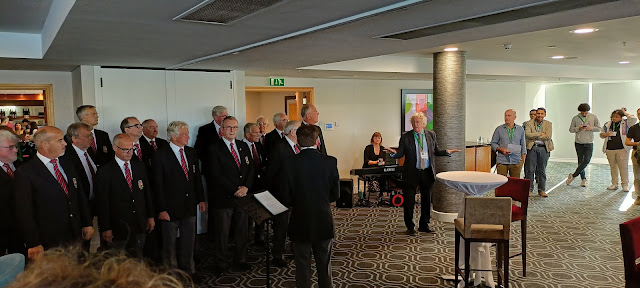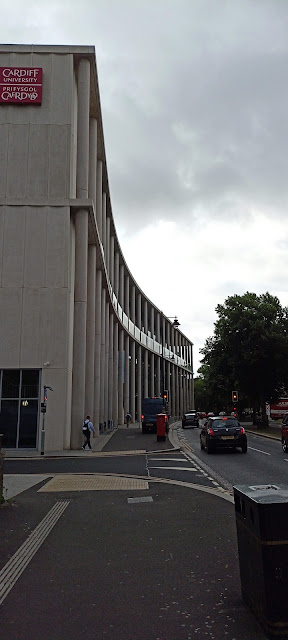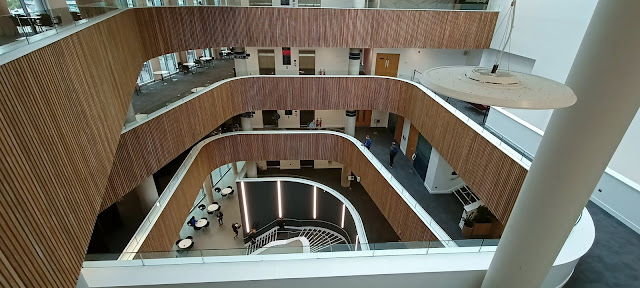Last week saw the annual ALMA "All Hands" meeting near Modena in the north of Italy. I don't often describe the stuff I do as part of the Czech ARC node, which quite honestly isn't as much as it should be, but I think that's about to change.
ALMA is of course the Atacama Large Millimetre Array, the world's largest radio telescope array located in – you've guessed it – Atacama in Chile. The ALMA Regional Centres are a European effort to provide user support to various local catchment areas, of which the Czech node supports eastern Europe. People do all kinds of activities for this, and mine is mainly the bog-standard stuff of answering user questions and testing the occasional procedure and software tool.
But since the pandemic started my main scientific project has been to recode FRELLED, my all-singing, all-dancing 3D FITS file viewer for Blender. I originally guestimated this would be a six month effort; it has been, ahh, a little bit longer than that. I ended up not only rewriting the entire thing but also doubling the length of the code and giving it a whole bunch of new capabilities, of which more later. And of course, this includes turning it into something ALMA-capable.
The Conferencing
First, the conference. After a flight in which the only thing of note was the obsessive sales pitch by the Ryanair steward who seemed to want to list every single item in the in-flight catalogue, in an oily, used-car-salesman voice (he also looked a lot like Doctor Who's Matt Smith), a short shuttle bus took us to a very nice though totally isolated hotel. This is the usual approach at these meetings. They'll keep you in comfort, but you have no chance of wandering off. It's a good way to focus.
 |
| The hotel was lovely but the surroundings were a nondescript highway that could have been in any country in the world. |
I'm not being selfish by not describing much of the rest of the conference. In fact "conference" is not really the right word for these events, of which only "meeting" seems to satisfactorily describe the mixture of management, planning, and technical talks that they consist of. I need not bore you with the details which are only relevant if you're actually involved with this, though there were a few more public-noteworthy talks this year.
First there was a prototype of some very fancy machine-learning code that can search the ALMA data archives for objects that are similar to ones the user specified. To me this seems invaluable well beyond the ALMA context; whenever you find a weird object, conventional searches of the literature to find similar features are extremely difficult. Another was the ALMA Software Repository, an effort I'm involved with to have a more centralised location for ALMA-useful software and contacts for user support. And there was a very nice one about a dedicated (not yet public) website describing ALMA's observations of the galactic centre – many of which are honestly spectacular – and again keeping everything tightly organised and well-presented. By being focused on a relatively small area, this gives a really detailed insight into a specific region with lots and lots of lovely images.
These events are also explicitly social as a way to ensure everyone keeps in touch. The trip to the Ferrari museum was for me every bit as bemusing as I expected : oh look, a car... oh look, there's another one. Oh, that's a blue one, how interesting ! I wonder if the next one will also have four wheels ? Good lord, it does ! How remarkable. And so on.
The most memorable part of this was for me the extremely Italian, extremely enthusiastic tour guide, who repeated everything at least five times. He had a demeanour of an odd mix of enthusiasm and worry, like he normally deals with large groups of very old people who he enjoys working with but is constantly expecting to fall over dead.
 |
| Brrmm brmmm. |
Anyway, the wine tasting and dinner that evening was much more my thing. A generous tasting which was almost a full glass per serving ! And the food... look, some stereotypes are just true. This is pasta country and with good reason, because it's very, very good pasta. I'm not sure it's possible to manage an entire day here without at least one pasta dish; probably if you try that someone will burst out of a hedgerow at you and ensure you don't go without your daily allowance. Couple that with the the loooong periods of sitting still and literally feeling my legs atrophying... I'm really not sure how I didn't explode.
 |
| I don't remember the name of the venue but the interior was on a much more industrial-scale than I was expecting, and not at all like its country-villa exterior. |
The Sciencening
Now I will indulge myself as briefly as I can with an ego-stroking. You must forgive me this because this is something I've worked on in one form or another for over a decade and the user base remains tiny. And by tiny I mean probably less than the number of years in development. I wasn't really sure if this was the right venue to present it, especially as I didn't have time to construct any more ALMA-specific demos and had to use good old-fashioned HI data sets instead. But from conversations beforehand, it became clear that people were very curious about this, which helped a lot.
In old version of FRELLED, which I published back in 2014, Blender's Python could not really include external modules. This meant I had to re-write a lot of basics, like transforming pixels into so-called "world coordinates" (that is, position on the sky) the hard way, something I do not enjoy doing at all. Consequently much of it had to be hard-coded that shouldn't have been, making it useful for HI data but anything else got quite hacky. Blender also had a lot of idiosyncrasies that were constantly troublesome to overcome.
All of these problems changed with more recent versions of Blender. This I put off using because the internal Python syntax between Blender 2.49 and 2.50* was completely replaced to the point of being a totally different language. Recoding this was not a straightforward exercise to say the least. But the advantages are manifold : FRELLED can now support any spectral line data cube (in principle any 3D FITS file at all though with some limitations); the new GUI system makes it far easier to add new buttons without having to recode everything else; it can display data volumetrically with far higher performance than the previous version and with more flexibility; it supports isosurfaces, 2D images and height maps; it can export to Blender 2.90 for a VR display; it can make figures and animations with annotations... and a whole lot more besides. And the code this time has designed to be far easier to both maintain and migrate to later versions of Blender, which haven't undergone anything like the complete Python change that happened with version 2.5.
* That's when the change happened, but the new FRELLED uses 2.79. When I started, the internal render capabilities were not good enough in 2.8 prototypes for what I needed, though that's subsequently been fixed.
I gave two demo videos and some still images of the major capabilities, and I could not have been happier with the audience response. When I explained that yes, I really had been working on this for ten years or more, people nodded and sincerely declared "I can believe that". "I want to use this and have my students use it !" said another. "That was impressive. Like, really impressive", said someone else. And my favourite, which I shall keep strictly anonymous, was, "I'm not excited by [much larger popular ALMA tool]. I'm excited by your software."
I was practically glowing.
But enough of this. Most of the last year has been spent debugging; very few known bugs remain, but without doubt more will be found with unexpected use cases. I still need to test with different sorts of FITS files, finish the documentation, and write a new paper on it. And the only fly in the ointment is that lots of people want to use it on a Mac, which isn't yet functional. Expect more on all this in due course.
The Travelling
Afterwards I had a few days to see the local sights. I stayed in a very basic but absolutely functional guest house in the centre of Bologna, a complete change from the luxury of the hotel but completely suited to my needs. Clean and comfortable, I'd happily recommend it for any Bologna budget travellers.
The place can be summarised best, I think, by the single English book that was in the desk shelves. There's a certain kind of place where you can find books from 1968 on Scottish clan tartans and that says all you need to know about it, really.
The first day consisted of wandering around the centre, eating gelato (seriously good) and visiting the cavernous cathedral. Even more so than most gothic cathedrals, the interior felt truly voluminous.
The next day a couple of us went to Florence. This took more effort than expected because the half-hour train arrived, everyone got on... and then it was delayed by a full hour. By the end, with little information forthcoming, I was really on the verge of giving up. But at the last minute, off we went.
Of course we headed straight for the star attraction, the cathedral. When you first glimpse this from the street it's an arresting sight. And close-up it doesn't disappoint. After so long in Prague it's good to see a totally different style of architecture, and the high-contrast colour scheme accentuates all the details marvellously. We couldn't go in the dome, which was fully booked, but we got tickets for the bell tower*. I regret nothing.
* The main interior of the cathedral is free but the line is very long. Perhaps on an early weekday morning it would be feasible.
As you go up level by level, Florence is transformed. I have to say I was a little disappointed by Florence as a street city (for that, Prague is still the clear winner for me); wandering around on ground level it's not really anything special. But from above it's far more interesting, much more like my expectations. It seems deliberately designed for epic jigsaw puzzles, and the dramatic sky certainly didn't let the side down either.
 |
| We got largely lucky with the weather, only caught out briefly in the rain. |
Afterwards we went into a museum included as part of the ticket, which was not bad, but I wish we'd queued for the luggage retrieval first. By this point I was already thirsty. By the time we were out of the museum I was sweating buckets (it was warm but not hot) and feeling like I had a hangover. This I attribute to a lack of my morning tea or other fluid; I'd had just one small glass of orange juice all day. Well, lesson learned.
 |
| I can't avoid thinking of this guy as the Big Bishop of Bologna even though this is in Florence. |
Fortunately getting back to Bologna was incident-free, and after I had plenty to drink I collapsed in my hotel room at about 7pm and didn't wake up until 10. Then, feeling very much better but now wide awake, I got on with some science blogging for a few hours and feel asleep again around 2am. I personally am not a fan of "total tourism" that some people practise. I want some break time from sightseeing and a few hours each day of doing normal things, otherwise I just feel shattered and can't enjoy it. From this perspective, solo travelling for me has some big advantages, even if it does start to feel overly-solitary after more than a few days.
The next day I did more wandering around Bologna. My trip up the tallest of the city's many watchtowers was cancelled due to sudden maintenance, so I went in a different, slightly shorter one instead. Again I regretted nothing, the weather was fantastic and the view was brilliant. Bologna too undergoes a transformation with altitude, though not quite so dramatically as Florence.
 |
| From the Torre Prendiparte. Unlike the taller tower you don't have to book ahead of time. Queue was 20 minutes. |
Actually I have to say I prefer Bologna as a city, at least from my brief visits. Bologna is a real studentsville and clearly a place to live first, visit second. It's busy but with residents. And its streets are just that bit architecturally nicer, more distinct, more medieval in feeling. If Bologna is bustling, Florence by contrast is a truly heaving tourist trap, undeniably spectacular (awe-inspiring, even !) in places but mediocre in others.
Finally, after a good long break back in my hotel, I walked the 4 km up the hill to the Sanctuary of St Luca, a wonderfully-situated, surprisingly large churchy thing at the end of a walk which is entirely covered by stone porticos (they have these everywhere and I love them) the whole way up the hill. This time I had plenty to drink and felt absolutely fine apart from, inevitably, my feet, but sod them they don't get to tell me what to do.
 |
| There were also good views of Bologna itself, but the Tuscan hillsides in the other directions were better. |
I arrived in the middle of a Catholic ceremony which I have to say felt very Kubrick. I mean, it's just daft to paint all forms of religion with the same cultish brush, but this one... no, this one definitely did feel like the sort of affair in which O Fortuna would suddenly start playing I'd find myself the surprise victim of the molestations of an overactive and sexually deprived Tom Cruise.
Urrgh, there's a thought.
The final day I went around the Bologna archaeological museum. Excellent place with an unexpected Egyptian collection and a fascinating, enormous Etruscan section, though a bit hit-and-miss on the English text (perfect translations, just variable in their availability, with some rooms translating every description of every artifact and others having none at all).
Finally it was time to head home. The only point I will say here is that Bologna airport has a very fast and efficient security section but beyond that it's honestly horrible : it's crowded to the point of being comparable to a music venue, and really no fun at all. For a brief moment I misread my flight delay as being 2 hours and my heart sank; how everyone else around me seemed perfectly comfortable with the highly limited seating, noisy and overheated environment I really don't know. Fortunately it was actually only a 20 minute delay and so my urge to burst into tears immediately receded.
And that's my second science trip this year. It was a only a week but felt like a month. That's enough conferences for now, methinks; time to get back to science proper. After I recover from this stinking little cold, which I'm blaming on the airport.













































